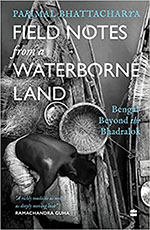One of the popular traditional games played by children in Bengal is kumir (crocodile)-danga (elevated land). One player who is designated as kumir has to catch the other players when they trespass their area (danga). This game encapsulates the very identity of Bengal and it is about the movement of players across the shifting territory of kumir and danga. Bengal, in this sense can be understood as a liminal space marked by the ever-shifting territory of people, their diverse cultural expressions, changing course of mighty rivers, and the unpredictable climate. Historically, Bengal has been a cultural and geographical frontier and after Partition, the western part of Bengal which came under India can also be considered as a political frontier. Field Notes from a Waterborne Land: Bengal Beyond the Bhadralok is an attempt to illustrate the shifting dynamics of Bengal on multiple frontiers, and to understand its imprint in socio-cultural, economic and political spheres of everyday life. The book is neither written as a travelogue nor does it adhere to any strict format of an ethnographic monograph. Yet, it opens up several contours of the everyday life of the people living in this region. On the personal front, the author who belongs to the bhadralok (genteel) class and whose social imagery is embedded in the cultural and intellectual spaces of urban Kolkata, tries to explore the other side of West Bengal by travelling to uncommon places from the tribal belt of West Bengal and northern Odisha, the region alongside the Indo-Bangladesh border, etched by the river Hooghly and its tributaries and lastly to the Gangetic delta of the Sunderbans. In this shifting terrain, nothing is constant and stable, and everything from geography, history, cultural boundaries, people, identities and nation-state has been in a perpetual state of ever-changing diffused boundaries. The only thing which appears to be constant in the book is the author’s concern for environmental degradation and its devastating impact on the fragile ecosystem of Bengal and on the lives of its people.

Between the Personal and the Political
Aditya Ranjan Kapoor
FIELD NOTES FROM A WATERBORNE LAND: BENGAL BEYOND THE BHADRALOK by Parimal Bhattacharya HarperCollins Publishers, Gurugram, 2022, 298 pp., 499.00
May 2022, volume 46, No 5
